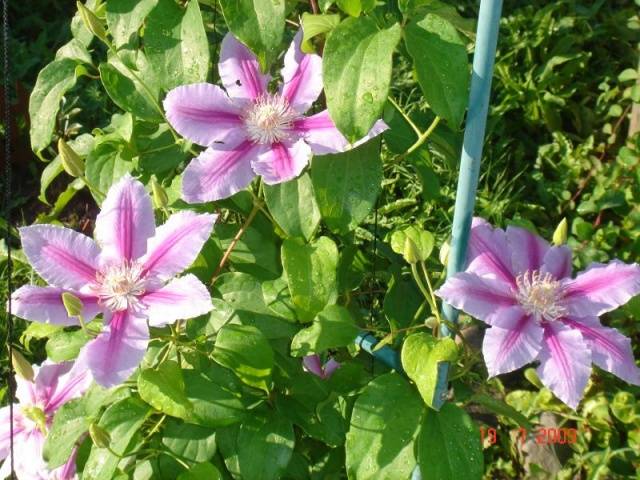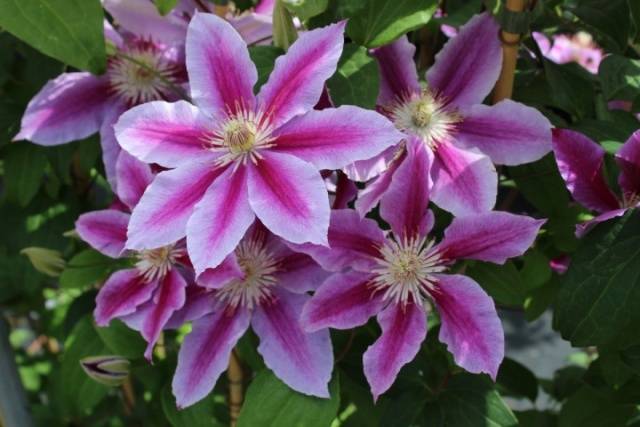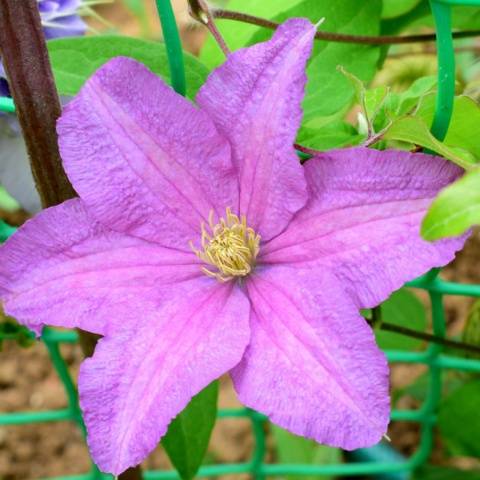The garden will shine with new colors if you plant the bright, flowering clematis Dr. Ruppel in it. Knowing the secrets of growing exquisite lianas, they choose the right planting site, in a corner protected from the heat of the sun, and feed them regularly. Clematis also requires shelter for the winter.
Description
Clematis Dr. Ruppel amazes with amazing large, 15-20 cm, flowers of a cheerful color in two shades of pink: with a more saturated stripe in the center of the petal and a light border. The color intensity varies depending on the location of the flower: it is lighter in the sun, brighter in partial shade. The gamma consists of pink, lavender tones, passing in the center of the petal to fuchsia. Eight large petals, slightly wavy at the edge, surround the center with long, light beige stamens. Flowers are admired twice: in late May and in August, early September. The spring flowering of the creeper is more powerful: the flowers are often semi-double.
Clematis roots spread up to 1 m to the sides and in depth, give many shoots. Lianas are moderately growing, they rise up to 2-2.5 m, in good conditions on fertile soil - up to 3 m. During the season, shoots develop from 1 to 2 m in length and up to 1 m in width. The vines have antennae with which it clings to any support: a wall, a tree trunk, trellises. Flowers are formed on last year's shoots. Unpretentious Clematis Dr. Ruppel 2 pruning groups are easy to grow and beginners in gardening.
Landing
Before purchasing clematis, it is necessary to study in detail the conditions for its cultivation.
Choosing a place and time for boarding
The optimal time for planting Doctor Ruppel vines is autumn. Seedlings with a closed root system are moved in spring or summer. Clematis cannot be planted in the sun, the whole plant suffers from this, and the decorativeness of the vine is especially lost. Flowers fade in the sun, quickly fade, the color of the petals becomes dull. On the south side, large-flowered vines are placed only in the northern regions, planted in tubs.
- The optimal exposure for clematis is east, southeast, west and southwest;
- Liana loves semi-shady corners where there are no strong gusts of wind or draft;
- The sun should illuminate the plant 5-6 hours a day, but not during the midday heat;
- In the southern regions, clematis do not feel very comfortable, but with sufficient watering and protected from drying out the near-stem circle, they develop and bloom in partial shade;
- Clematis do not like stagnant water, including rain runoff.
Selection of seedlings
Experienced gardeners prefer to buy flowering, closed-root clematis. If a seedling has open roots, it is carefully examined when buying.
- The fibrous form, up to 20-30 cm in volume, will provide better survival;
- Sapling shoots up to 40 cm high, strong, without scratches on the bark.
Soil requirements
Large-flowered clematis prefer moist, loose, drained soils with a neutral acidity reaction. Fertile loams hold moisture best.Heavy, saline and acidic soils, when laying a hole for clematis, optimize and add missing components, up to replacing the soil.
How is landing
The size of the well for clematis Dr. Ruppel depends on the soil: up to 70 cm in diameter on heavy, 50 cm on light. The depth corresponds to the width of the fossa. Pebbles, ceramics, expanded clay are laid down, 5-8 kg of sand are added. The top layer of garden soil is mixed with 10 kg of humus, 7-8 kg of peat, 100-150 g of dolomite flour and wood ash, 50-80 g of superphosphate or any complex flower fertilizer. It is better to install a support at the same time as digging a hole, so as not to injure the root system of the plant later.
- A bucket of mullein solution is poured into the hole (1: 5);
- Clematis roots are carefully laid out or a seedling is placed from a pot into a hole on a prepared substrate, without destroying a lump of soil;
- The seedling is covered with earth above 5-7 cm of the level that was in the pot to create new buds.
Care
Clematis of the Dr. Ruppel variety requires minimal care.
Top dressing
The plant is fertilized 4 times a season, after half a month. In the first year of a young liana, fertilization from the hole is enough.
- Clematis Dr. Ruppel in the spring, after pruning, fertilize with a solution of 10 liters of water 50-80 g of ammonium nitrate or 40 g of carbamide. Pour 10 liters for an adult plant, half for a young one;
- The same composition is repeated in the budding phase;
- At the end of July, clematis is fed with a complex fertilizer according to the instructions or with a mullein.
Loosening and mulching
The soil is loosened, removed weeds... To retain moisture, Dr. Ruppel's clematis trunk circle is mulched with humus, straw, peat or grass. Letniki and low ground covers are also planted, which will protect the roots of the moisture-loving vine from overheating.
Watering
The large-flowered clematis of the Dr. Ruppel variety is watered once a week. In the heat, the frequency of watering the vines is doubled. One plant requires 10-30 liters of water.
Pruning
In the middle lane, it is necessary to prune clematis.
- Having opened clematis Dr. Ruppel after winter, cut the shoots a few centimeters, remove the damaged vines, tie the rest to the support;
- After the first wave of flowering, the vines are cut to the first buds, giving the opportunity to create new shoots that will bloom at the end of summer;
- The seedling in the first year is cut low above the ground.
Shelter for the winter
After pruning, the seedling is covered with straw, spruce branches, burlap on top, agrotextile. Adult clematis vines of the Doctor Ruppel variety are slightly cut off, by 20-50 cm, removed from the support, carefully folded and laid on a bed of straw, dry grass, and the remains of large plants. The same material is used to cover the bush.
Disease and pest control
Having removed the shelter in spring, clematis protects against fungal diseases, especially from wilting, which affects plants on acidic and heavy soils. Spill 1 bush with a solution: for 10 liters of water 200 g of dolomite flour or lime. Vines are prophylactically sprayed with a solution of 5 g of carbamide in 10 liters of water. Noticing wilting, the affected shoot is removed, 10 liters of a solution of 5 g of biofungicide "Trichophlor" are poured under the plant. The root does not get sick, the liana is transplanted in the fall, adding "Tricoflor" or "Trichodermin" to the hole.
In early spring, the plant is treated with a 1% solution of copper sulfate. For aphids on clematis, use an infusion of soap or insecticides.
Reproduction
Clematis varieties Dr. Ruppel are propagated by cuttings, layering and dividing the bush.
- The roots of the plant are carefully separated with a shovel and part of the bush is transferred to a new hole;
- For layering in the spring, they drop in a liana, leaving the top above the soil, often watered. Shoots are transplanted in the fall or next spring;
- Cuttings are cut from a healthy shoot so that each has 1 node. They are placed in a growth stimulant solution, the leaves are cut in half and planted in the substrate. Cuttings take root after 16-25 days, transplanted after a year.
Application in landscape design
The decorativeness of flowers and the whole clematis plant of the Doctor Ruppel variety is used to decorate buildings and fences. Liana is planted for vertical gardening of the gazebo, porch, trunk of an old tree. Plants look spectacular next to climbing rose bushes or morning glory. At the bottom of the vines are placed annuals, hosts, cuff, heuchera.
Testimonials
Conclusion
The variety has proven itself well in the middle climatic zone. Plant care is simple. Having chosen the right place for a blooming vine, you can admire its beauty for years.














